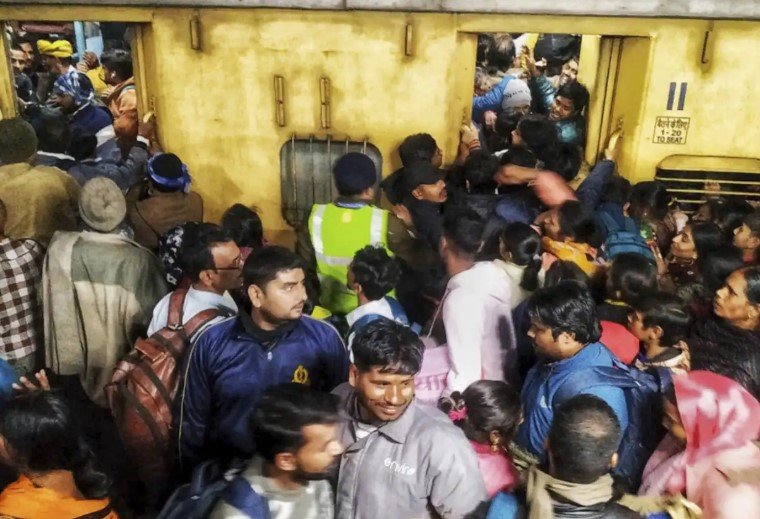A devastating stampede at New Delhi Railway Station left 18 people dead on the night of Saturday, February 15, 2025, as crowds surged to catch trains bound for the Maha Kumbh in Prayagraj. Eyewitnesses shared chilling accounts of the chaos that unfolded in the crowded station, where people were pushed, trampled, and helpless in the face of the rush.
A Night of Chaos at New Delhi Railway Station
It was a scene of utter panic and desperation. Hundreds of people packed New Delhi Railway Station late Saturday night, all hoping to catch a train to Prayagraj for the Maha Kumbh. With massive crowds and heightened urgency, a fatal stampede broke out as the crowd rushed towards the trains.
The weight of the crowd became overwhelming, with people pushing and shoving, trying desperately to find space. In the madness, the sound of screams filled the air, but many voices were drowned out by the chaos. Some people lost their balance, tripping and falling, while others were caught in a crushing wave of bodies.
“I could hear people crying for help, but there was nothing we could do,” said an eyewitness, visibly shaken by the memory of the disaster. “It was a matter of survival at that point. People were falling over one another, and I could see bodies on the platform.” The grief and shock of the moment were still raw for many who witnessed the carnage.

The Gripping Desperation of the Victims
The stampede occurred just hours before the trains were scheduled to depart. People were eager to attend one of the largest religious gatherings in the world, the Maha Kumbh in Prayagraj. As the rush intensified, it became nearly impossible to move freely through the station, especially at the gates where people gathered in waves, each trying to board a train.
With the atmosphere already tense due to the large turnout, every delay only heightened the desperation of the crowd. Eyewitnesses mentioned how even the smallest of movements or delays led to people becoming agitated. “It felt like everyone was in a rush to be the first one on the train, and that led to this tragedy,” one person recalled.
For many, it was more than just a stampede; it was a nightmare. Some managed to escape the crush, while others were trapped, helpless as the frantic crowd surged forward.
- The bodies of the deceased were scattered on the platform, adding to the horror of the scene.
- Medical personnel rushed to the scene, but the severity of the situation meant that some lives were lost before help could arrive.
Authorities Respond to the Tragedy
In the aftermath of the stampede, emergency services and railway authorities launched a swift operation to address the situation. Police and paramedics were seen moving quickly to clear the platform, but by then, the damage was already done.
The Ministry of Railways has since promised an investigation into the incident, calling it a tragedy that could have been avoided. The authorities are looking into crowd control measures and whether proper safety protocols were followed to manage the overwhelming number of people traveling for the Kumbh Mela.
In the wake of the stampede, many are asking why the station wasn’t better equipped to handle such large crowds. New Delhi Railway Station, one of the busiest in India, is notorious for its overcrowding, especially during major religious events like the Maha Kumbh. The scale of this disaster has brought renewed attention to the challenges of managing crowds during such massive events.
Impact on Passengers and Public Sentiment
For the families of the victims, the loss is incalculable. Eyewitnesses to the tragedy have described how families, in the midst of their own grief, looked for their loved ones amid the wreckage. One passenger recalled searching through the crowd for hours, hoping to find their missing relatives.
The public’s sentiment has ranged from outrage to sorrow, with many questioning the safety protocols in place. Social media platforms have been flooded with calls for accountability, with many people expressing concern over the growing number of incidents of overcrowding at public spaces. The question remains: How can tragedies like this be prevented in the future?
The stampede has not only raised questions about crowd management but also about the safety of large gatherings in India, which continues to host millions for religious and cultural events each year. Given the scale of this disaster, public pressure is mounting for better planning and safety measures.
Investigations and Moving Forward
In the wake of this tragedy, an investigation has already been launched by the local authorities. Early reports suggest that the lack of proper crowd control and barriers may have contributed to the incident. With more than 100 people injured and 18 confirmed dead, this incident marks a heartbreaking chapter in the history of India’s public transportation system.
As the authorities continue to sift through the evidence, the focus will now shift to preventing such incidents in the future. Whether it’s improving infrastructure, streamlining crowd control, or increasing the number of personnel on the ground, this stampede has made one thing clear: better planning is essential to avoid a similar disaster in the future.
